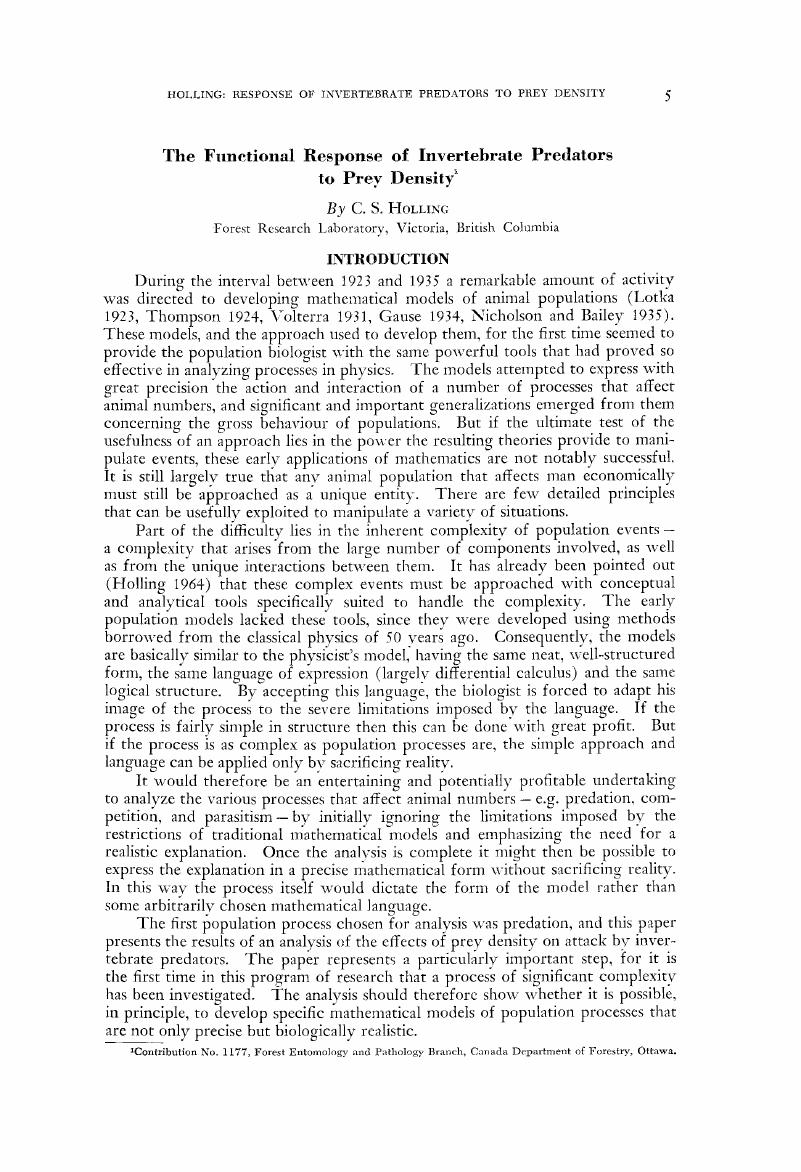Crossref Citations
This article has been cited by the following publications. This list is generated based on data provided by Crossref.
Holling, Crawford S.
1966.
Systems Analysis in Ecology.
p.
195.
GELPERIN, ALAN
1968.
Feeding Behaviour of the Praying Mantis: A Learned Modification.
Nature,
Vol. 219,
Issue. 5152,
p.
399.
Messenger, P. S.
1968.
BIOCLIMATIC STUDIES OF THE APHID PARASITE PRAON EXSOLETUM: I. EFFECTS OF TEMPERATURE ON THE FUNCTIONAL RESPONSE OF FEMALES TO VARYING HOST DENSITIES.
The Canadian Entomologist,
Vol. 100,
Issue. 7,
p.
728.
Griffiths, K. J.
and
Holling, C. S.
1969.
A COMPETITION SUBMODEL FOR PARASITES AND PREDATORS.
The Canadian Entomologist,
Vol. 101,
Issue. 8,
p.
785.
Huffaker, C. B.
and
Kennett, C. E.
1969.
SOME ASPECTS OF ASSESSING EFFICIENCY OF NATURAL ENEMIES.
The Canadian Entomologist,
Vol. 101,
Issue. 4,
p.
425.
Mukerji, M. K.
and
LeRoux, E. J.
1969.
THE EFFECT OF PREDATOR AGE ON THE FUNCTIONAL RESPONSE OF PODISUS MACULIVENTRIS TO THE PREY SIZE OF GALLERIA MELLONELLA.
The Canadian Entomologist,
Vol. 101,
Issue. 3,
p.
314.
Huffaker, C. B.
van de Vrie, M.
and
McMurtry, J. A.
1970.
Ecology of tetranychid mites and their natural enemies: A review: II. Tetranychid populations and their possible control by predators: An evaluation.
Hilgardia,
Vol. 40,
Issue. 11,
p.
391.
Wilbert, Hubert
1970.
Feind-Beute-Systeme in kybernetischer Sicht.
Oecologia,
Vol. 5,
Issue. 4,
p.
347.
Dixon, Kenneth R.
and
Cornwell, George W.
1970.
A mathematical model for predator and prey populations.
Population Ecology,
Vol. 12,
Issue. 2,
p.
127.
LAWTON, J. H.
1971.
Maximum and actual field feeding‐rates in larvae of the damselfly Pyrrhosoma nymphula (Sulzer) (Odonata: Zygoptera).
Freshwater Biology,
Vol. 1,
Issue. 1,
p.
99.
Safranyik, L.
and
Vithayasai, C.
1971.
SOME CHARACTERISTICS OF THE SPATIAL ARRANGEMENT OF ATTACKS BY THE MOUNTAIN PINE BEETLE, DENDROCTONUS PONDEROSAE (COLEOPTERA: SCOLYTIDAE), ON LODGEPOLE PINE: APPENDIX: STATISTICAL ANALYSIS OF THE "HOLE-PAIRS" EXPERIMENT.
The Canadian Entomologist,
Vol. 103,
Issue. 11,
p.
1607.
Stark, R. W.
and
Smith, Ray F.
1971.
Biological Control.
p.
331.
LASSITER, RAY R.
and
HAYNE, DON W.
1971.
Systems Analysis and Simulation in Ecology.
p.
367.
GLASS, NORMAN R.
1971.
Systems Analysis and Simulation in Ecology.
p.
325.
HUBBELL, STEPHEN P.
1971.
Systems Analysis and Simulation in Ecology.
p.
269.
Healey, M. C.
1971.
The distribution and abundance of sand gobies, Gobius minutus, in the Ythan estuary.
Journal of Zoology,
Vol. 163,
Issue. 2,
p.
177.
BLEDSOE, LEWIS J.
and
VAN DYNE, GEORGE M.
1971.
Systems Analysis and Simulation in Ecology.
p.
479.
Stark, R. W.
and
Smith, Ray F.
1971.
Biological Control.
p.
331.
Paloheimo, Jyri E.
1971.
A stochastic theory of search: Implications for predator-prey situations.
Mathematical Biosciences,
Vol. 12,
Issue. 1-2,
p.
105.
RYKIEL, EDWARD J.
and
KUENZEL, NANCY T.
1971.
Systems Analysis and Simulation in Ecology.
p.
513.



